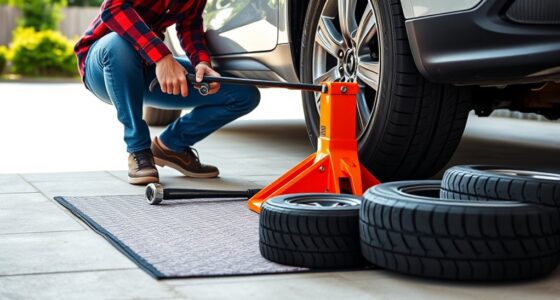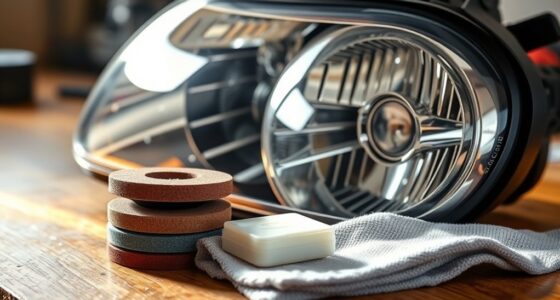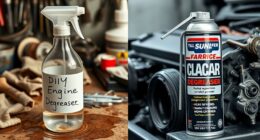Changing your engine oil at home is simple and saves you money. First, warm up your engine, then turn it off and secure the vehicle. Locate the drain plug and loosen it to let old oil flow into a catch pan. Remove and replace the oil filter, then add fresh oil through the fill cap. Afterward, check levels and clean up spills. If you keep going, you’ll discover even more tips to make the process smoother and safer.
Key Takeaways
- Warm up the engine and gather necessary tools, including oil, filter, wrench, catch pan, funnel, gloves, and rags.
- Carefully loosen and drain the old oil from the drain plug into the catch pan, then replace and tighten the plug.
- Remove the old oil filter with a wrench, apply oil to the new filter’s gasket, and install it securely.
- Add the correct amount and type of new oil through the fill cap, then start and run the engine briefly before checking the level.
- Clean tools and spills, properly dispose of used oil and filter, and verify the oil level is optimal for engine performance.

Changing your engine oil at home can save you money and give you greater control over your vehicle’s maintenance. It’s a straightforward process that, with the right tools and a bit of preparation, you can do in your driveway or garage. Before you start, ensure you have fresh oil suited for your vehicle’s needs, paying attention to the recommended oil viscosity—this ensures proper lubrication and engine performance. The oil filter is equally important, as it traps contaminants and keeps your engine running smoothly. Using a high-quality oil filter compatible with your car will help extend engine life and improve efficiency.
Changing your oil at home saves money and offers better vehicle maintenance control.
First, warm up your engine by running it for a few minutes. Warm oil flows better and carries away more debris, making the draining process cleaner. Then, turn off your engine, engage the parking brake, and gather all necessary tools—such as a wrench, oil catch pan, funnel, gloves, and rags. Locate the drain plug, which is usually underneath the oil pan, and carefully loosen it with your wrench. Be prepared for the oil to flow out quickly into the catch pan. Let it drain completely, which might take a few minutes, ensuring all old oil is removed. Proper drainage is essential for maintaining engine health and avoiding sludge buildup.
Next, move to the oil filter. Using an oil filter wrench, carefully unscrew the old filter. Before installing the new one, apply a little fresh oil to the rubber gasket of the new filter—this helps create a proper seal and makes future removal easier. Screw in the new oil filter by hand first, then tighten it slightly more with the wrench, avoiding over-tightening. Now, replace the drain plug securely, ensuring it’s snug but not overtightened, which could damage the threads.
Before adding new oil, check the oil level and viscosity recommended for your car—these details are usually found in your owner’s manual. Remove the oil fill cap, place your funnel into the opening, and pour in the correct amount of fresh oil. Be cautious not to overfill; you can always add more later if needed. After pouring, replace the oil fill cap and start your engine. Let it run for a minute or two, then turn off the engine and wait a few minutes to allow the oil to settle. Finally, use the dipstick to verify the oil level, adding more if necessary. Clean up any spilled oil and dispose of the used oil and filter properly according to local regulations. Doing this yourself helps you understand your vehicle better, saves money, and ensures your engine stays in top shape. Regularly monitoring the oil level and quality can help prevent costly repairs and ensure optimal engine performance.
Frequently Asked Questions
How Often Should I Change My Engine Oil?
You should change your engine oil every 3,000 to 5,000 miles, but check your vehicle’s owner’s manual for specific recommendations. When you do, replace the oil filter and loosen the drain plug to remove old oil. Regular oil changes help your engine run smoothly and prolong its lifespan. Keep an eye on oil levels and quality between changes to guarantee peak performance.
What Type of Oil Is Best for My Vehicle?
You should choose the best oil for your vehicle based on its manufacturer’s recommendations, typically found in your owner’s manual. Synthetic blends offer a good balance of performance and cost, providing better protection than conventional oil. When selecting oil filters, opt for high-quality types designed for your engine. Always verify compatibility, and consider synthetic blends if you want enhanced engine protection without the full cost of synthetic oil.
Can I Recycle Old Engine Oil Safely?
Yes, you can recycle old engine oil safely. You should take it to a certified recycling center that handles oil filtration properly. Never pour used oil down the drain or onto the ground, as it harms the environment. Many auto shops and recycling centers accept used oil and ensure it’s processed correctly. Always store the oil in a sealed container until you can deliver it to the proper facility.
What Tools Do I Need for an At-Home Oil Change?
You’ll need a few essential tools for an at-home oil change. First, grab an oil filter wrench to remove the old filter easily. A drain pan will catch the used oil, preventing messes. Don’t forget a socket wrench or ratchet to unscrew the drain plug, and have a funnel handy for pouring new oil. With these tools, you’ll streamline the process and keep your workspace clean.
How Do I Dispose of Used Oil Properly?
You should store used oil in a sealed, leak-proof container, like a plastic jug, and keep it in a cool, dry place away from children. When you’re ready to dispose of it, take it to a certified recycling center that accepts used oil and oil filter recycling. Never pour used oil down the drain or on the ground. Proper used oil storage and recycling help protect the environment and comply with local regulations.
Conclusion
Now that you’ve learned how to change your engine oil at home, you’re truly taking the wheel of your vehicle’s care. Like a skilled captain steering through calm and storm, you’ve gained the confidence to keep your engine running smoothly. Remember, regular maintenance isn’t just a chore, it’s your vehicle’s secret to a long, reliable life. So go ahead—take control, and keep your car running like a well-tuned legend.









